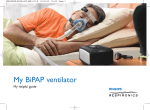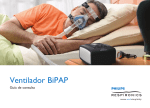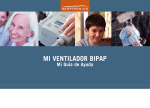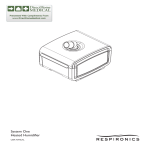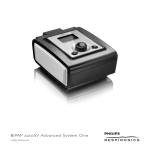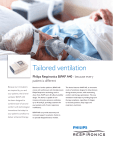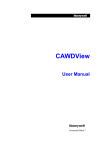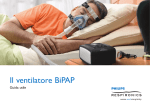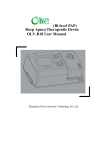Download My BiPAP ventilator
Transcript
My BiPAP ventilator My helpful guide Inhale. Exhale. And everything in between. How does it work? Brief Overview The lungs are vital organs that bring fresh oxygen into the body and remove carbon dioxide and other gases the body does not need. The lungs, however, do not work alone. They depend on the muscles of the rib cage to help – especially the large, dome-shaped muscle called the diaphragm. When we breathe in, the diaphragm contracts and the inhaled air passes through the mouth and nose for the mucous membranes to warm and moisten the air and filter the dust. Inspiration Diaphragm contracts, lungs inflate Then the air passes through the upper airways, trachea and bronchus to the alveoli – tiny air sacs surrounded by blood capillaries. It is at the alveoli level that gas exchange takes place: the blood eliminates its wastes (carbon dioxide, CO2) and it is replaced with oxygen (O2) to feed the body’s cells. It is hard to imagine that this entire process is repeated continuously, every minute of your life. But sometimes, chronic conditions cause the respiratory system to fail, and you will need to rely on respiratory equipment to help move air in and out of the lungs effectively. Alveolus Expiration The diaphragm returns into place, the air charged with CO2 is removed Blood capillaries Why do I have difficulties breathing? For some people, the routine process of taking air in and out is far from simple. Diseases that affect your lungs or respiratory muscles also challenge your quality of life and your overall health. Your breathing may be interrupted either because your muscles are too weak to pull air into your lungs or because your airways are blocked. Two reasons that may cause difficulty in breathing are: • When a neuromuscular disease affects the nerves that control the respiratory muscles, breathing becomes strained and weak. You may become short of breath when you exert yourself or while you’re lying in bed. You might also find it’s difficult to cough and to control swallowing. These symptoms can lead to infection or to blocked airways. • Chronic Obstructive Pulmonary Disease (COPD) refers to a group of lung diseases (such as emphysema and chronic bronchitis) that obstruct air from easily entering and exiting the lungs, avoiding therefore the proper elimination of carbon dioxide. Patients with COPD struggle to breathe and often have a chronic cough that produces sputum. Medication, oxygen therapy and pulmonary rehabilitation are treatment options used to reduce and control the symptoms of COPD. A machine to assist breathing may be recommended in the latter stages of this disease. Why do I need ventilation? Noninvasive ventilation (NIV) will mechanically assist your breathing in order to treat the respiratory symptoms of the disease. It helps you to be more active and independent in your daily life. NIV, when prescribed by your doctor and respiratory therapist (according to the instructions for use), will help you to: 1 rest your respiratory muscles 2 decrease the work of breathing 3 reduce daytime sleepiness and morning headaches 4 improve sleep quality 5 maintain or improve the oxygen/carbon dioxide levels in the blood 6 inflate the lungs more fully 7 enjoy a better quality of life How will my ventilator will help me? Your doctor has prescribed you a BiPAP S/T or BiPAP AVAPS ventilator. This device will assist your breathing, providing air into your lungs through a tube and a mask. 2 1 Air is drawn from the back of the device. A blower within the device delivers a prescribed amount of air through a tube and a mask into your lungs. The level of pressure will be higher when you inhale and will decrease as you exhale. 4 3 Air is exhaled through the small exhalation holes on the mask. The air from the device moves through the tube to the mask, and then into your lungs. Using the device regularly and following your medical specialist's recommendations (regular physical activity, bronchus clearance, etc.) will help you improve your quality of life. How do I use my device? 1 Connect the tube to the device and the mask to the tube. 2 Ensure that your BiPAP ventilator is plugged to an AC power source. 3 When the device is plugged, the main menu screen appears. Make sure Therapy / is highlighted and press the wheel to begin therapy. Therapy Comfort Info Setup ext View 4 IIcon View ext View If using a humidifier, from Setup / menu, press Humidifier / and use the wheel to adjust the heating level from 1 (50% relative humidity) to 5 (90% relative humidity). When the device is on, the humidifier icon on the front panel is highlighted. You can directly change the humidifier level using the wheel. 5 If necessary, activate the ramp (progressive increase of the pressure). 6 From Setup / menu, press Back light / to access the screen backlight setting. Setup Back Back light hPa/cmH2O Humidifier Text View on cmH2O cmH2O 3 3 Icon View 7 From Comfort / menu, you have access to the comfort options that your healthcare professional may have prescribed. You can use the wheel to modify these settings. 8 To switch off the device, while in the main monitor screen, press the wheel for a few seconds to stop therapy. H I How do I use my humidifier? Filling 1 (a) Lift humidifier door up until it locks in place. Do not force door higher than the locked position. (b) Grasp front of chamber and slide toward you. 2 (a) Gently push tab located inside round opening on top of chamber. (b) Separate top and bottom of chamber. 3 Fill bottom chamber with distilled water. 4 Observe maximum fill lines located on sides of chamber. 5 Do not overfill. Reassemble the chamber by placing the hinges on lid over the two tabs on back of chamber. Close lid until it locks in place with an audible click. Insert filled chamber into humidifier. Undocking Hold entire unit at each end and slide release latch to the right. What should I do if an alarm sounds? 1. Press the Alarm Silence button . 2. Refer to the table below for the action to take. 3. Press the control wheel to reset the alarm. In any of the below cases, if the alarm continues despite the indications, contact your medical specialist or homecare provider. Alarm cause and visual indicator Screen display Loss of Power Blank screen (Text) Screen display Blank screen Red flashing Ventilator Inoperative Low Pressure cm H2O Red flashing High Pressure High Pressure Red flashing Apnea Apnea Red flashing User action The device shuts down. Check your power connections. Make sure there is power at the outlet or power source. Restore power to the device. If you have a battery, connect it to the device. The device shuts down. Contact your homecare provider for service. Ventilator Inoperative Solid red Low Pressure Alarm (Icon) cm H2O The device operates. This could be caused by an excessive leak or blockage or a device malfunction. Check for the following: dirty inlet filters, blocked air intake, excessive leak in the patient circuit. The device operates. This may be caused by a malfunctioning device. Remove power from the device. Restore power. The device operates. This alarm is generated when an apnea event occurs during therapy. Report the alarm to your medical specialist or homecare provider. Continue using your device. In any of the below cases, if the alarm continues despite the indications, contact your medical specialist or homecare provider. Alarm cause and visual indicator Low Minute Ventilation Screen display (Text) Screen display MinVent The device operates. This alarm occurs when the calculated minute ventilation is less than or equal to the alarm setting. Continue using your device. Low Tidal Volume VTE The device operates. This alarm occurs when the device is unable to reach the target tidal volume setting. Continue using your device. Red flashing Patient Disconnect Patient Disconnect The device operates. This alarm occurs when the patient circuit is disconnected or has a large leak. Reconnect the patient circuit or fix the leak. Low Voltage The device operates, the humidifier shuts down. The alarm is caused when input power at the device, either from an AC outlet or battery, falls below the acceptable limit for 10 seconds. If the device is plugged into a wall outlet, unplug the device and then plug it back in. If you are using a battery, replace the battery or plug the device into an AC outlet. Reinsert SD Card The device operates. This alarm occurs when the device cannot read the SD card.The card may be inserted incorrectly. Remove the SD card and reinsert. If the alert continues to occur, replace the SD card or contact your medical specialist or homecare provider. Red flashing Low Input Voltage Yellow flashing SD Card: Remove and Reinsert Humidifier Failure Flashing User action Low Minute Vent Red flashing Low Tidal Volume (Icon) The device operates, the humidifier shuts down. Alert is present for 12 minutes or until the condition is fixed. Turn off airflow and reconnect the humidifier to the device according to the humidifier instructions. How to clean my device and accessories The device The grey foam filter • Ensure the device is unplugged before cleaning it. Use a damp cloth and a soft detergent to clean the ventilator. Ensure the device is completely dry before plugging it in again. • The grey filter must be washed once every two weeks with mild soapy water. Rince thoroughly and dry. The mask, the headgear and the tube m pironics.co rtseries.res wwwcomfo • Hand wash the mask regularly in mild soapy water. Rince thoroughly and air dry. • Hand wash the headgear and the tube once a week in mild soapy water. Rince thoroughly and air dry. The humidifier • The humidifier chamber should be washed regularly. To do so, remove the humidifier chamber from the humidifier unit, then separate bottom and top parts of the humidifier chamber and place them in the dishwasher. Do not use bleach, alcohol or strong house detergent that contains alcohol to clean your device and accessories. Inspect the device and all circuit parts for damage after cleaning. Any damaged parts should be replaced. My prescription: ❑ BiPAP S/T ❑S ❑ S/T IPAP EPAP RR/BPM Ti Rise Time ❑ Humidifier ❑ BiPAP AVAPS ❑ ❑❑❑❑ 1 2 3 4 5 ❑ ❑❑❑❑ 1 2 3 4 5 1 .......... ❑S EPAP RR/BPM Ti ❑ Humidifier This is not a medical prescription. My recommendations: My doctor: My homecare provider: This leaflet does not substitute the user manual. Refer to user manual provided with the device for more information. ❑ PC IPAP Rise Time 6 ❑ S/T ❑T .......... ❑ ❑❑❑❑ 1 2 3 4 5 ❑ ❑❑❑❑ 1 2 3 4 5 6 2 ❑ AVAPS IPAP min. IPAP max. Target Vte .......... Philips Healthcare is part of Royal Philips How to reach us www.philips.com/healthcare [email protected] Asia +49 7031 463 2254 Philips Respironics 1010 Murry Ridge Lane Murrysville, PA 15668 USA Customer Service +1 724 387 4000 Europe, Middle East, Africa +49 7031 463 2254 Latin America +55 11 2125 0744 North America +1 425 487 7000 800 285 5585 (toll free, US only) Philips Respironics Asia Pacific +65 6882 5282 Philips Respironics Australia +61 (2) 9947 0440 1300 766 488 (toll free, Australia only) Philips Respironics China +86 400 828 6665 +86 800 828 6665 Philips Respironics Deutschland +49 8152 93 06 0 Philips Respironics France +33 2 51 89 36 00 Philips Respironics Italy +39 039 203 1 Philips Respironics Sweden +46 8 120 45 900 Philips Respironics Switzerland +41 6 27 45 17 50 Philips Respironics United Kingdom +44 800 1300 845 www.philips.com/respironics Respironics, BiPAP and AVAPS are trademarks of Respironics, Inc., all rights reserved. Please visit www.philips.com/respironics © 2014 Koninklijke Philips N.V. CAUTION: US federal law restricts these devices to sale by or on the order of a physician. All rights are reserved. Philips Healthcare reserves the right to make changes in specifications and/or to discontinue any product at any time without notice or obligation and will not be liable for any consequences resulting from the use of this publication. Broudy RP 7/8/14 MCI 4105846 PN 1078595












